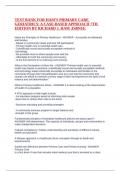TEST BANK FOR HAM’S PRIMARY CARE
GERIATRICS: A CASE-BASED APPROACH 7TH
EDITION BY RICHARD J. HAM :ISBN10;
Name the Principles of Primary Healthcare - ANSWER - Accessible to individuals
and families
- Based on community needs and their full participation
- Primary health care is essential health care.
- Scientifically sound and socially acceptable methods &
technology.
- Be provided close to where people work and live.
- Affordable for both the community and country.
- Is the first element of a continuing care process
What is the Declaration of Alma Ata - ANSWER "Primary health care is essential
health care based on practical, scientifically sound and socially acceptable methods
and technology made universally accessible to individuals and families in the
community through their full participation and at a cost that the community and
country can afford to maintain at every stage of their development in the spirit of self
reliance and self determination."
What is Primary Healthcare About - ANSWER It is about looking at the determinants
of health of a population
A PCH approach to falls might include:
- An education program aimed at informing older people
about how to reduce their risks in the home
- Brochure educating and providing strategies
- A community exercise program to target balance and
strength in this group
Fundamental principles of Australian healthcare policies are based upon? -
ANSWER Self-determinism: The capacity of individuals, groups and communities to
make independent decisions
Cultural Competency: Implies understanding and sensitivity of different cultural
beliefs and practices
A lifespan approach: to healthcare (from conception through to death and
bereavement).
Explain the difference between Primary Care and Primary Nursing - ANSWER
Primary Care
Is a first level of care that includes initial medical care that is provided to a client.
,Has an illness focus /disease management
Services are not necessarily accessible, affordable, acceptable or available to a
client.
Primary Nursing
A client is managed by a single nurse.
The nurse cares for the client personally
Is responsible for scheduling all procedures and activities
Does not guarantee accessible, affordable, acceptable and available care
Selective vs. Comprehensive Healthcare - ANSWER Selective - Health achieved
through medical interventions., Client is a passive recipient.
Service provision is not holistic, equitable or sustainable.
Comprehensive - Holistic understanding and implementation of healthcare.
Wellbeing that is equitable, empowering and sustainable.
What is the difference between Equality and Equity - ANSWER Equality - Aims to
ensure that everyone gets the same things in order to enjoy full, healthy lives.
Equity - Involves trying to understand and give people what they need to enjoy full,
healthy lives.
What is Primary Prevention - ANSWER - Promotes health
- Prevents illness/disease
Includes:
Health Promotion
Health Education, sex education
Immunisation., flu vaccines etc.
What is Secondary Prevention - ANSWER Prevent progression to disease through
early detection
and intervention.
Screening - cancer screening, sun check clinics, Hearing
and vision screening
What is Tertiary Prevention - ANSWER Care in: Health & illness, Rehabilitation,
Assisting individuals to cope with disease, Prevents immobility through passive
exercise, Improves quality of life
Examples: Diabetes education & monitoring, Silver chain home nursing, OT
providing home aids: shower chairs
Name the Social Determinants of Health - ANSWER Stress, Social Status, Early life,
Social Exclusion, Income, Social Support, Addiction, Food/Transport, Unemployment
, Explain Social Justice - ANSWER Social justice is justice in terms of the distribution
of wealth, opportunities, and privileges within a society.
Reflects the general rejection of discrimination based on distinctions between class,
gender, ethnicity, sexual orientation or culture.
Links between Social Justice and PHC
Examples of remote areas, lack of choice, life saving equipment eg. dialysis
machines
Explain Social Capital - ANSWER the networks of relationships among people who
live and work in a particular society, enabling that society to function effectively.
What is Social Inclusion - ANSWER Assumes each person needs to have access to
resources to have health, achieve successfully and participate fully in society
What is Social Exclusion - ANSWER Is the outcome of multiple deprivations that
prevent individuals and groups from participating fully in society
Factors that compound to create social exclusion:
- Dislocation
- Discrimination
- Marginalisation
- Poor levels of education and schooling
- Low income and unemployment
- Inadequate housing
- Lifestyle behaviours
Name the at risk population groups in Australia for concerning health needs & higher
risk of disease: - ANSWER Indigenous Health
People living with disabilities
Rural and remote area populations
Prison population
Refugee/Asylum seekers
What is a Community - ANSWER Any group which has a common connection or
common interest, or at least one common
characteristic
Examples: church community, university students
What is Community Health - ANSWER Health status of a defined group of people, or
community, and the actions and conditions that protect and improve the health of the
community.
It includes activities which are designed to enhance the quality of life and promote
the wellbeing of the total population of the community




